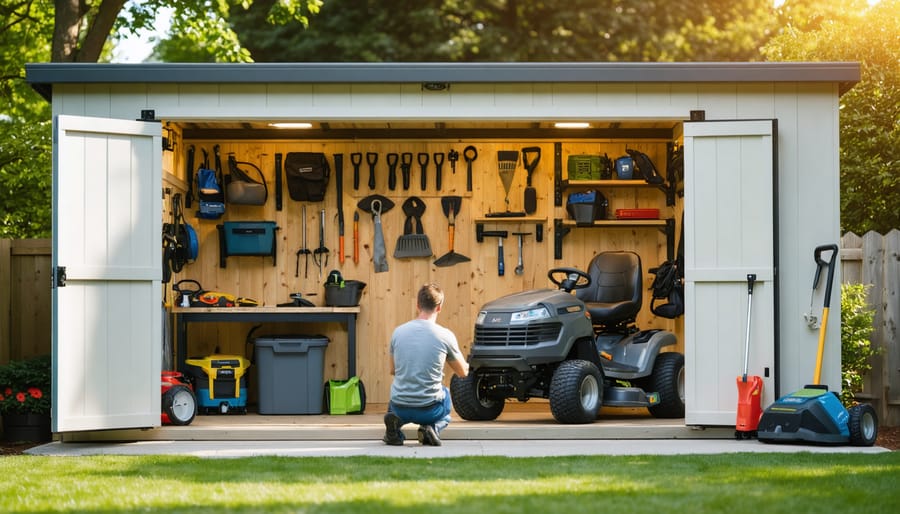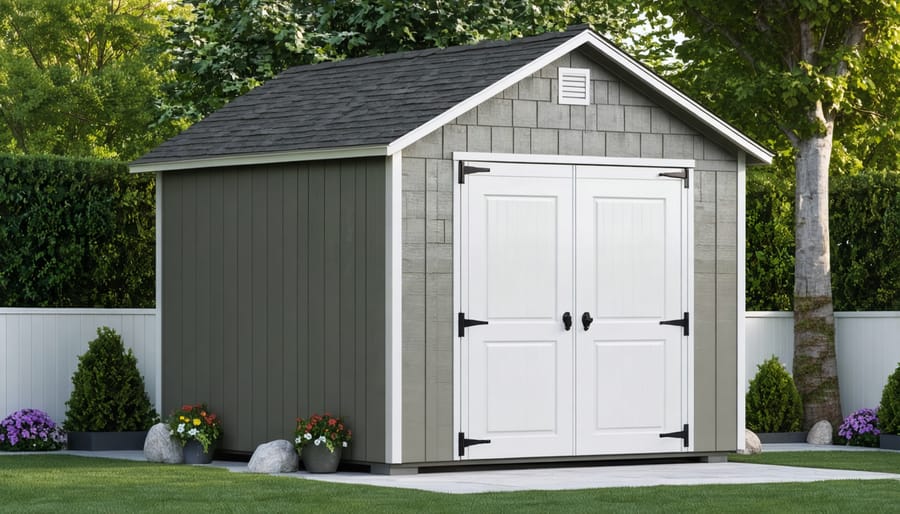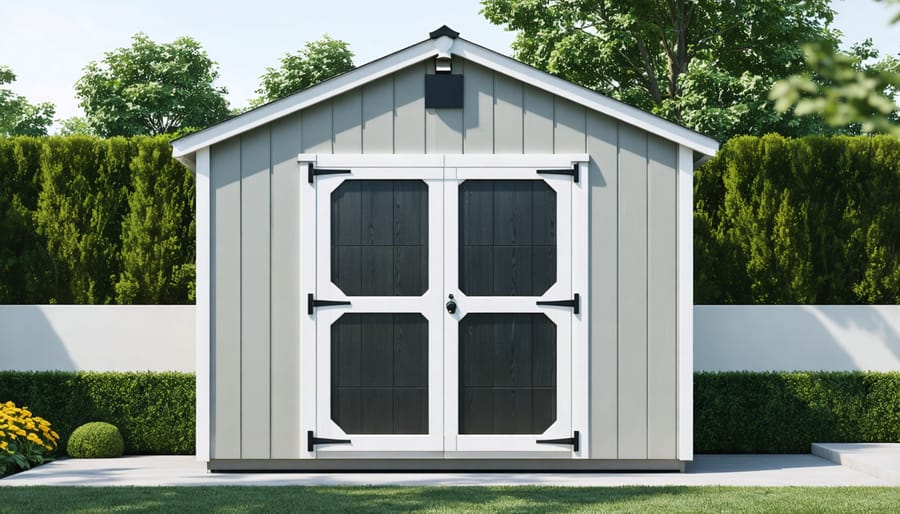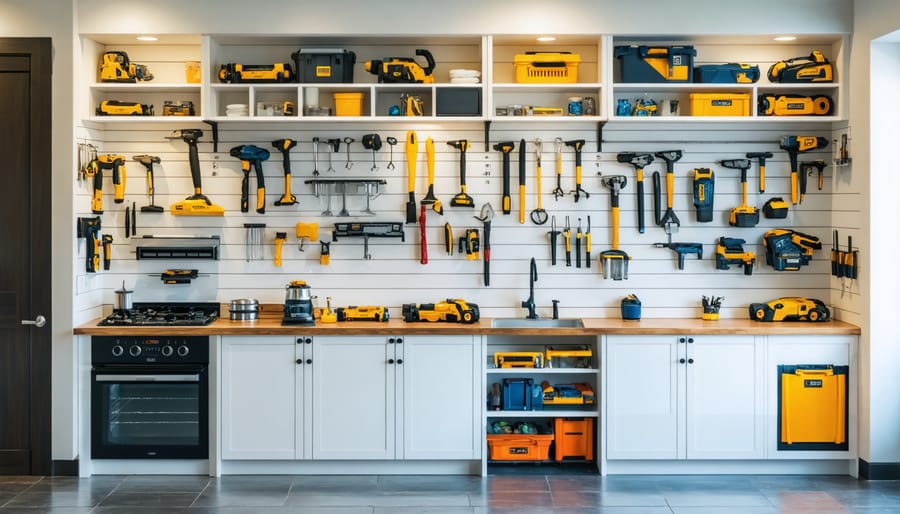AI Just Changed How You Design Your Perfect Storage Shed

**Design your equipment shed with precision by measuring your largest tools first, then adding 30% extra space for maneuvering and future purchases.** Most homeowners underestimate their storage needs and end up with cramped, inefficient spaces that require costly expansions within two years.
**Map your workflow before choosing a layout.** Position frequently-used items near the entrance, seasonal equipment toward the back, and create dedicated zones for lawn care, power tools, and gardening supplies. This approach, tested by thousands of shed owners, cuts retrieval time by half and prevents the frustrating “avalanche effect” when accessing buried items.
**Leverage AI-powered customization tools to visualize your exact setup before building.** These digital platforms let you test different door placements, shelving configurations, and lighting options in minutes—eliminating expensive mistakes that plague traditional shed planning. You’ll see precisely how your riding mower fits alongside your workbench, whether double doors or a single wide entry works better, and which wall heights accommodate your tallest equipment.
The technology removes guesswork from critical decisions like foundation type, ventilation placement, and electrical requirements. Real users report saving $500-$1,200 by avoiding over-building while ensuring their shed actually meets their specific needs. Whether you’re storing basic lawn equipment or creating a full workshop space, smart design planning transforms a simple storage box into an organized, efficient system that grows with your needs.
What AI-Powered Shed Customization Actually Means (And Why It Matters)
Think of AI-powered shed customization as having a knowledgeable friend who helps you figure out exactly what you need—without the guesswork. Instead of staring at catalog pages wondering if a 10×12 shed will actually fit your lawnmower, snowblower, and garden tools, these smart tools walk you through the process step by step.
Here’s how it works in practice: You start by answering simple questions about what you’re storing, where the shed will go, and what matters most to you. The AI then crunches this information and suggests shed sizes, layouts, and features that match your specific situation. Some tools even let you upload a photo of your backyard to see how different shed styles will look in your actual space—no imagination required.
The real magic happens when you realize you’re not just picking a shed from a catalog anymore. One homeowner, Sarah from Michigan, shared how an AI tool helped her discover she needed more vertical storage than floor space for her gardening equipment. “I was about to buy a bigger shed than necessary,” she explained. “The AI suggested a smaller footprint with better shelving, saving me money and yard space.”
These tools also help you avoid common mistakes, like choosing a shed that looks great but doesn’t have enough door clearance for your riding mower, or selecting materials that won’t hold up in your climate. The technology essentially acts as a personal consultant, translating your needs into practical design choices—making the whole process less overwhelming and more confidence-inspiring.

The Real Problems AI Customization Solves for Your Shed Design
Getting the Size Right the First Time
One of the biggest regrets shed buyers face is ending up with too little—or too much—space. Traditional shed shopping often involves guessing at dimensions or settling for standard sizes that don’t quite fit your needs. AI-powered design tools eliminate this guesswork by helping you calculate the perfect footprint for your specific equipment.
Here’s how it works: You simply input what you plan to store—lawn mower, snow blower, garden tools, bikes, or seasonal decorations. The AI considers each item’s dimensions, adds appropriate circulation space for easy access, and factors in any future storage needs you mention. Within seconds, you receive precise size recommendations tailored to your inventory.
Sarah from Vermont discovered this firsthand: “I thought I needed a 10×12 shed, but the AI tool showed me that an 8×10 would actually work perfectly for my needs, saving me $600.” The system prevented her from both overcrowding and overspending.
This technology also helps you visualize different layout configurations, ensuring doors open fully, walkways remain clear, and frequently-used items stay accessible. Getting the dimensions right from the start means no regrets, no wasted money, and a shed that truly serves your needs for years to come.
Seeing Your Shed Before You Buy It
One of the most exciting advances in shed shopping is the ability to see exactly what you’re getting before making a purchase. Thanks to AR visualization technology, you can now view different shed designs right in your own backyard using just your smartphone or tablet.
This technology lets you experiment with various sizes, roof styles, siding materials, and color combinations to see what actually works with your home’s exterior and landscape. No more guessing whether that barn-red shed will clash with your house or wondering if a 10×12 will overwhelm your garden space.
Many homeowners find this feature incredibly helpful for avoiding costly mistakes. As one customer shared, “I thought I wanted gray siding until I saw it virtually placed in my yard—it looked too industrial. Switching to cream saved me from buyer’s remorse.”
Beyond aesthetics, visualization tools help you identify practical issues too, like whether there’s enough clearance from property lines or if the doors will open without hitting your fence. It’s like having a crystal ball for your backyard project.
Matching Your Home’s Style Without Guesswork
Gone are the days of flipping through endless catalogs wondering if that barn-red shed will clash with your gray siding. AI-powered design tools take the guesswork out of matching your home’s style by analyzing photos of your property and suggesting complementary options that actually work together.
These smart tools examine your home’s exterior colors, roofing materials, and architectural style, then recommend shed designs that coordinate beautifully. If you have a craftsman-style home with earth tones and cedar accents, the AI might suggest a shed with matching trim details and a similar color palette. For modern homes with clean lines and neutral colors, it’ll steer you toward sleek, minimalist designs.
The technology even considers surrounding landscaping and hardscaping elements. One homeowner shared how the AI noticed her stone pathway and suggested incorporating similar stone accents into her shed’s foundation design—a detail she hadn’t considered but loved.
This intelligent matching means you’ll feel confident your new shed enhances your property’s curb appeal rather than looking like an afterthought. No design degree required.

Key Features to Look for in AI Shed Design Tools
Smart Space Planning and Layout Suggestions
Gone are the days of walking into your shed and wondering where everything should go. Modern AI-powered design tools now analyze your specific storage needs and recommend floor plans that actually make sense for your equipment. Simply input what you’re storing—lawn mowers, tools, bikes, gardening supplies—and these smart planners suggest optimal shelf heights, wall-mounted solutions, and traffic flow patterns.
These tools consider practical factors like door swing clearance, your most frequently accessed items, and seasonal storage rotation. For example, if you’re storing both small hand tools and larger equipment, the software might recommend a smart storage organization setup with pegboards near the entrance and deeper shelving toward the back.
Many homeowners report that following AI-generated layouts saves them from costly mistakes like installing shelves too high or wasting valuable floor space. One DIY enthusiast shared how her customized plan maximized vertical storage, doubling her shed’s capacity without changing its footprint. The best part? These recommendations adapt as your needs change, helping you reorganize without starting from scratch.
Material and Budget Comparisons
One of the most valuable features of AI-powered shed design tools is their ability to compare materials side-by-side in seconds. Instead of spending hours researching prices and calling suppliers, you can instantly see how wood, metal, vinyl, and composite options stack up against each other—both in upfront costs and long-term value.
The AI does more than just show price tags. It factors in durability, maintenance requirements, and lifespan to give you the complete picture. For example, while a vinyl shed might cost more initially than basic wood, the AI can demonstrate how you’ll save money over ten years with minimal maintenance and no repainting. Similarly, metal sheds might show higher durability scores for harsh weather conditions, helping you understand why the price difference makes sense for your climate.
This instant comparison helps you make smarter material choices that align with both your budget and your practical needs. You’ll see real numbers showing how a slightly higher investment today could mean fewer repairs and replacements tomorrow—taking the guesswork out of what’s truly the best value for your specific situation.
Foundation and Site Preparation Guidance
AI-powered tools take the guesswork out of foundation planning by analyzing your specific yard conditions. Simply input details about your soil type, slope, and drainage patterns, and receive customized recommendations for the most suitable foundation—whether that’s concrete piers, gravel pads, or full slabs.
These smart systems consider local frost lines and moisture levels to prevent future settling or shifting. For homeowners dealing with uneven terrain, the AI suggests strategic placement options and necessary grading work before installation begins.
One homeowner shared how the technology identified a drainage issue they hadn’t noticed, saving them from potential water damage down the road. The AI also calculates material quantities needed for proper ground preparation, eliminating costly guesswork and multiple hardware store trips. This digital guidance ensures your equipment shed sits on a stable, long-lasting foundation from day one.
Weather and Climate Considerations
Modern shed design tools take the guesswork out of weather planning by analyzing your zip code and climate zone. These smart platforms automatically recommend materials that’ll stand up to your local conditions—whether that’s moisture-resistant siding for humid coastal areas or reinforced roofing for heavy snow regions.
The technology considers temperature swings, rainfall patterns, and humidity levels to suggest proper ventilation systems. For example, homeowners in hot, dry climates might receive recommendations for ridge vents and reflective roofing, while those in damp regions get guidance on enhanced airflow and moisture barriers.
“I was surprised when the tool flagged my original material choices,” shares Michigan homeowner Tom Chen. “It suggested upgraded insulation and weatherstripping based on our harsh winters—advice that’s already paid off during our first cold season.”
These climate-specific suggestions help you avoid costly mistakes and ensure your equipment stays protected year-round, all without requiring expertise in local building requirements.
Real Homeowners Who Got It Right With AI Design
Meet Sarah from Colorado, who was drowning in garden chaos. Her tools were scattered across the garage, patio, and basement, making spring planting feel like a treasure hunt. Using AI design tools, she mapped out exactly where she needed her most-used items—rakes, shovels, and her beloved collection of watering cans. The AI suggested a 10×12 shed with vertical wall storage, pegboard systems, and a potting bench near the window for natural light. “I uploaded a photo of all my tools, and the AI calculated exactly how much wall space I needed,” Sarah explains. “Now everything has its place, and I actually enjoy getting ready to garden.”
Then there’s Mike in Oregon, who needed a proper workshop but didn’t want to sacrifice yard space. He used AI-powered design to create a dual-purpose shed that houses his woodworking equipment on one side and lawn care equipment on the other. The AI recommended specific layout configurations based on the dimensions of his table saw and mower, ensuring he could safely move around both sides. The technology even suggested electrical outlet placement for his power tools. “I never would have thought about dust collection zones,” Mike shares, “but the AI flagged that my wood dust could damage my mower’s engine if stored together without a partition.”
Finally, there’s the Rodriguez family in Texas, who needed to store camping gear, bikes, and seasonal decorations. By working with customizable shed solutions, they designed an 8×10 shed with adjustable shelving that adapts as their storage needs change throughout the year. The AI helped them visualize how ceiling-mounted bike racks would free up valuable floor space for plastic storage bins.

Making AI Work for Your Specific Shed Project
Start With an Inventory of What You’re Storing
Before you explore AI-powered shed customization, take time to create a detailed inventory of everything you plan to store. Walk through your garage, basement, or yard and jot down each item—from lawn mowers and gardening tools to seasonal decorations and sports equipment. Don’t just list items; grab a tape measure and note their dimensions, especially for bulky equipment like riding mowers or workbenches.
This inventory becomes the foundation for accurate AI recommendations. When you input “riding lawn mower, 60 inches long” rather than just “lawn equipment,” the AI can calculate precise space requirements and suggest optimal layouts. Many homeowners skip this step and end up with sheds that feel cramped or waste valuable space. One homeowner shared how measuring her garden tools revealed she needed vertical storage for long-handled items—a feature the AI then prioritized in her design. Spending 30 minutes on inventory now saves you from costly design mistakes later.
Take Photos of Your Space
Getting the best results from AI shed design tools starts with good visuals of your space. Snap photos from multiple angles showing where you plan to place your equipment shed—include shots of the full area, close-ups of any slopes or obstacles, and views from your house looking toward the spot. Don’t worry about professional photography; even smartphone pics work great! These images help AI tools understand your yard’s unique features like existing structures, trees, or utility boxes that might affect placement. The more context you provide, the better the AI can suggest shed sizes that fit comfortably and recommend positioning that maximizes accessibility while complementing your property’s layout. Think of it as giving the AI a virtual walk-through of your backyard!
Don’t Skip the 3D Walkthrough
Before you click that final “order” button, take full advantage of the 3D walkthrough feature—it’s one of the most valuable tools in AI-powered shed customization. Think of it as a virtual test drive for your investment.
Walking through your customized shed digitally lets you catch potential issues that might not be obvious in a flat design view. You’ll quickly notice if that side door opens awkwardly close to your lawn equipment area, or if the window placement creates an odd dark corner where you planned to set up your workbench.
Many homeowners have shared that spending just ten extra minutes exploring their shed from different angles saved them from costly modifications later. One DIY enthusiast discovered during his walkthrough that his original door placement would have blocked access to overhead storage—a problem easily fixed before construction but expensive to change afterward.
Pay special attention to how natural light flows through windows at different times of day, check sight lines from the entrance, and imagine yourself moving equipment in and out. This virtual exploration helps ensure your shed works perfectly for your specific needs before a single board is cut.
What AI Can’t Do (Yet) and Where Human Judgment Still Wins
While AI-powered shed customization tools are incredibly helpful for visualizing designs and exploring layout options, they’re not quite ready to handle everything on their own. Think of them as your enthusiastic assistant rather than your complete project manager—there are still several areas where your judgment and professional expertise make all the difference.
**Building codes and permits** top the list of things AI simply can’t navigate for you. Every municipality has unique requirements for setbacks, foundation types, and maximum sizes before permits are needed. An AI might generate a gorgeous 12×16 shed design, but it won’t know that your local code requires structures over 120 square feet to be permitted, or that you need to maintain a 5-foot setback from your property line instead of the 3-foot minimum in the next town over.
**Homeowners association restrictions** add another layer of complexity that’s entirely human territory. Many HOAs have specific rules about shed colors, roof styles, or even whether sheds are visible from the street. You’ll need to review your HOA guidelines and possibly submit your plans for approval—something no AI can do on your behalf.
**Site-specific challenges** require on-the-ground assessment. Is that spot you chose actually level, or will you need significant grading? Are there underground utilities, tree roots, or drainage issues? Does that corner really get as much sun as you remember, or will moisture be a concern? Walking your property and making these observations remains firmly in human hands.
Finally, **personal aesthetic preferences** often involve gut feelings that are hard to quantify. You might see an AI-generated design and think, “It’s nice, but it’s just not *me*.” Trust that instinct—your shed should feel like it belongs in your space and reflects your style.
Designing the perfect equipment shed no longer means second-guessing measurements, worrying about wasted space, or settling for generic solutions that don’t quite fit your needs. AI-powered customization tools have transformed what used to be an overwhelming process into an accessible, confidence-building experience. You can now visualize exactly how your shed will look on your property, experiment with different layouts until everything clicks, and make informed decisions about materials and features—all before spending a single dollar.
The real beauty of this technology isn’t just the convenience; it’s the peace of mind knowing your investment will truly serve your specific situation. Whether you’re storing lawn equipment, workshop tools, or seasonal gear, AI customization ensures nothing is left to chance. You’ll avoid costly mistakes, maximize every square foot, and create a storage solution that genuinely works for your lifestyle.
Ready to explore your options? Approach AI design tools with curiosity rather than hesitation. They’re built to guide you, not confuse you. Take your time experimenting with configurations, ask questions, and trust that you’re making smart, personalized choices for your property and budget.

